You’ll find the most accurate barometric altitude watches from Garmin’s Fenix 7 Pro Solar and Instinct 3 Solar, which offer precise elevation tracking with dual-band GPS integration. Suunto’s Core delivers exceptional accuracy within three-foot increments, while Coros Apex 2 provides impressive 45-hour battery life with titanium durability. These watches feature manual calibration capabilities, storm alerts, and rugged construction for extreme conditions. The complete comparison below reveals which specific features matter most for your adventures.
Top Barometric Altitude Watch Brands and Their Strengths
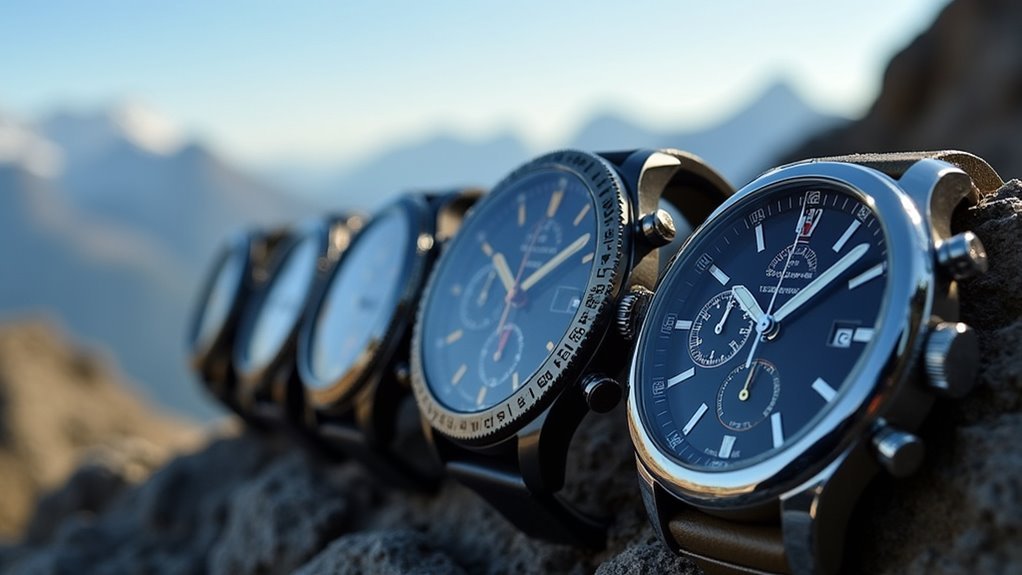
When choosing a barometric altitude watch, you’ll find that several brands have established themselves as leaders through their specialized strengths and innovations.
Suunto excels in precision barometric tracking with three-foot elevation increments and storm alerts, perfect for outdoor safety.
Suunto’s three-foot elevation precision and integrated storm alerts make it the top choice for serious outdoor enthusiasts prioritizing safety.
Coros delivers exceptional durability with titanium construction and impressive 40-hour battery life in tracking mode.
Garmin leads the industry with highly accurate barometric sensors and extensive GPS integration, trusted by professionals. The Garmin fenix 8 series includes advanced QZSS and BeiDou navigation sensors for enhanced positioning accuracy.
Polar and Apple Watch offer smartwatch versatility, combining altitude tracking with health monitoring and connectivity features.
Casio rounds out the field with affordable, rugged designs emphasizing shock resistance and long battery life for budget-conscious adventurers.
Essential Features to Look for in Barometric Altitude Watches
Before you invest in a barometric altitude watch, you’ll need to understand the key features that separate professional-grade instruments from basic models.
1. High-Precision Barometric Sensors – You’ll want sensors that display altitude in fine increments (1 meter or 1 foot) with manual calibration capability.
Fused data systems combining barometric readings with GPS provide the most reliable measurements.
2. Extended Battery Life with Power Management – Look for multi-day or multi-week battery performance.
Solar charging capabilities and power-saving modes that conserve energy during non-GPS operation are vital for extended outdoor adventures.
3. Clear Data Display and Readability – Choose watches with high-resolution screens, customizable data fields, and backlit displays.
Graphical trends for pressure and altitude help with decision-making in dynamic conditions.
4. Environmental Durability – Water resistance, shock protection, and extreme temperature tolerance guarantee reliable operation in harsh conditions. Check that the sensor port remains unobstructed by clothing or debris during outdoor activities to maintain accurate pressure readings.
Best Garmin Models for Elevation Tracking and Outdoor Adventures
You’ll find Garmin leads the market with GPS watches that excel at barometric altitude tracking through dual-band GPS technology and built-in barometric altimeters.
Their top models like the Fenix 7 Pro Solar, Instinct 3 Solar, and Forerunner 965 deliver precise elevation readings while offering solar charging capabilities that extend battery life for multi-day adventures. The latest releases include the Forerunner 970 with 15 days of battery life and advanced tracking capabilities for serious athletes.
These rugged devices combine accurate altitude measurements with advanced navigation features, making them essential tools for serious hikers, runners, and outdoor enthusiasts who demand reliable elevation data.
Top Garmin GPS Models
Five standout Garmin series dominate the barometric altitude watch market, each engineered for specific outdoor pursuits and elevation tracking needs.
You’ll find the Fenix 7 leads with multi-band GPS and detailed topographic mapping for precise elevation readings.
The Forerunner 965 targets serious athletes with dual-band GPS and advanced training metrics.
For rugged adventures, the Instinct 2 Solar combines solar charging with reliable barometric altitude tracking.
The Enduro 2 delivers exceptional battery life up to 150 hours for ultramarathoners requiring extended elevation monitoring. These watches provide elevation readings with +/-10 feet accuracy at any given point within their operational range.
- Fenix 7: Multi-band GPS with barometric altimeter for professional-grade accuracy
- Forerunner 965: Dual-band GPS optimized for athletic performance and elevation training
- Instinct 2 Solar: Solar-powered durability with dependable altitude sensors
- Enduro 2: Ultra-long battery life supporting weeks of continuous elevation tracking
Elevation Accuracy Features
Accurate elevation tracking depends on how well your Garmin watch combines barometric pressure data with GPS signals.
Dual-band GPS models like the Forerunner 965 and Fenix 7 Pro deliver exceptional reliability through satellite redundancy and advanced sensor fusion. You’ll get altitude resolution to the nearest foot or meter, with automatic adjustments for weather conditions.
Manual calibration greatly improves precision when you’re at known elevation points.
The Instinct series excels in harsh outdoor environments, while Fenix 7 Pro and Enduro 3 offer superior sensor integration. Your watch tracks total ascent, descent, and cumulative elevation changes with real-time graphs for route analysis. Testing revealed that the Forerunner 965 achieved remarkable accuracy with only a 1 foot difference from official elevation data during challenging mountain ascents.
ClimbPro provides live elevation profiles during climbs, helping you manage effort and pacing effectively.
Outdoor Adventure Capabilities
When you’re planning serious outdoor adventures, Garmin’s top-tier models deliver extensive capabilities that extend far beyond basic elevation tracking.
These watches combine ABC sensors with multisport support, tracking hiking, running, cycling, and swimming with advanced metrics. You’ll get built-in GPS navigation with offline maps and backtracking features for wilderness safety.
Premium models offer solar charging for weeks-long expeditions, while reinforced cases handle extreme temperatures and harsh conditions. The auto mode automatically switches between altimeter and barometer functions to provide optimal monitoring based on your current activity and conditions.
- Garmin Instinct 3 Solar – Features ABC sensors, solar charging, and rugged construction for demanding outdoor use
- Garmin Fenix 7 – Offers advanced navigation with offline maps and extended battery life options
- Garmin Enduro 2 – Specializes in ultralong battery performance with detailed elevation tracking
- Garmin Epix (Gen 2) – Provides AMOLED display with enhanced mapping and outdoor-specific features
Suunto Core Vs Other Entry-Level Barometric Altimeter Watches
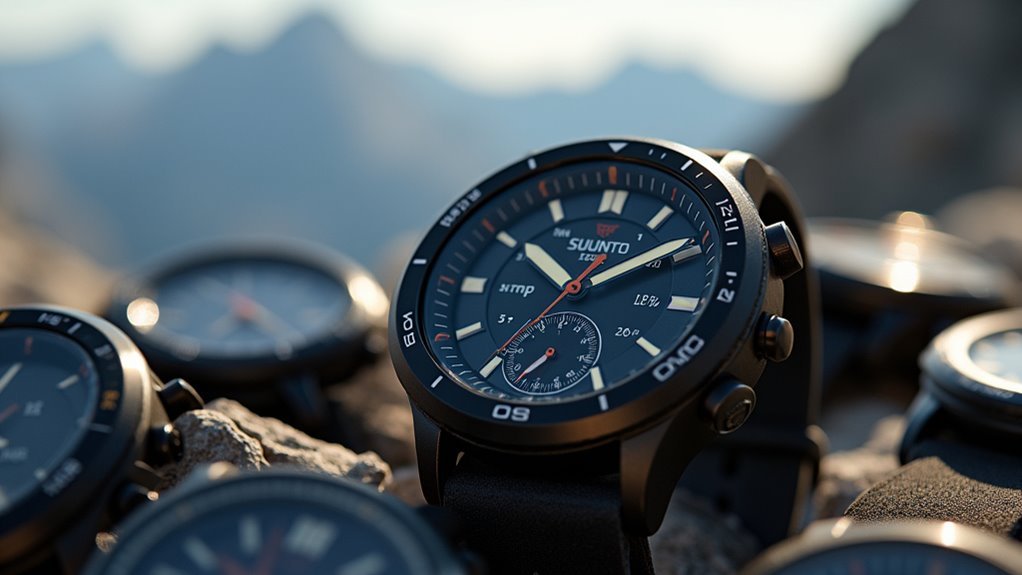
When you’re comparing the Suunto Core to other entry-level barometric altimeter watches, you’ll notice it stands out as a full ABC watch that doesn’t rely on GPS for altitude readings.
The Core’s 49mm display offers better visibility than many smaller entry-level models, while its user-friendly interface provides quick access to essential features like timer, stopwatch, and sunrise/sunset times that basic watches often lack.
You’ll find the Core’s rugged build quality and durable materials give it an edge over lighter, less robust entry-level alternatives designed for casual outdoor use. The Suunto Core includes outdoor essentials that make it particularly suited for extended outdoor activities and challenging conditions.
Suunto Core Features
Five core functions make the Suunto Core a standout choice among entry-level barometric altimeter watches.
You’ll get precise altitude measurements with 1-meter resolution, while the barometer delivers weather forecasts and storm warnings. The digital compass provides 5° accuracy for navigation, and you can track snorkeling depths up to 10 meters.
Key features that set it apart:
- Weather Intelligence – Storm alarm and sunrise/sunset times keep you informed of changing conditions
- Robust Construction – Composite case, mineral crystal glass, and aluminum bezel withstand outdoor adventures
- Extended Battery Life – 12-month operation with user-replaceable CR2032 battery
- Versatile Design – 30-meter water resistance and lightweight 64g construction for daily wear
You’ll appreciate its multilingual support and customizable backlight for varied conditions. The watch includes helpful video tutorials covering essential functions like compass calibration, battery replacement, and strap changes to maximize your outdoor experience.
Entry-Level Watch Comparisons
Three distinct categories of entry-level barometric altimeter watches compete directly with the Suunto Core, each offering different strengths for outdoor enthusiasts.
Traditional ABC watches like Casio Pro Trek offer similar altimeter, barometer, and compass functions at lower price points, though they may sacrifice sensor accuracy or data logging capabilities.
GPS-enabled models such as Garmin Instinct and Coros Pace provide multisport tracking and sleep monitoring beyond basic ABC functions, but you’ll face more complex interfaces and shorter battery life with rechargeable systems. These GPS watches can connect to smartphones via Bluetooth for notifications and enhanced functionality.
Budget alternatives deliver core barometric features but often compromise on display readability and durability.
The Suunto Core’s replaceable CR2032 battery, proven one-year longevity, and straightforward interface position it as the reliability-focused option when you prioritize field repairability over advanced connectivity features.
Coros Apex 2 Performance Review for Athletic Training
The Coros Apex 2 delivers exceptional value for athletes seeking a detailed training companion without breaking the bank.
You’ll get precise barometric altitude tracking alongside a complete ABC suite that enhances your outdoor navigation capabilities. The titanium alloy construction and sapphire glass guarantee durability during intense training sessions.
Key Performance Features:
- Extended Battery Life – Up to 45 hours in GPS mode supports ultra-endurance activities without frequent charging
- Multi-Sport Versatility – All-encompassing activity modes cover running, hiking, and strength training with structured workout support
- Advanced Navigation – Free global offline maps and multiband GNSS connectivity deliver reliable positioning in remote locations
- Professional-Grade Sensors – Next-generation optical heart rate monitoring and barometric altitude measurement provide accurate training data
You’ll appreciate the straightforward interface that doesn’t compromise on essential features serious athletes demand. The watch operates reliably across extreme temperatures from -20℃ to 50℃, ensuring consistent performance during challenging outdoor conditions.
Solar-Powered Altimeter Watches: Casio and Beyond
While conventional watches drain batteries during extended backcountry adventures, solar-powered altimeter watches harness natural light to keep your essential navigation tools running indefinitely.
You’ll find Casio’s PAW 1300 delivers solid performance at $170, featuring altimeter, barometer, and compass functions with atomic timekeeping accuracy. However, you’ll need regular calibration for precise altitude readings.
Garmin’s Instinct series offers superior smart features and extended battery life, though you’ll pay premium prices reaching $800+. These lightweight models integrate GPS capabilities alongside traditional barometric functions.
Solar charging provides significant advantages: you’ll eliminate battery replacement costs, reduce environmental impact, and guarantee reliability during multi-day expeditions. The Garmin fēnix 7 Sapphire Solar Edition achieves up to three weeks of battery life through its advanced solar charging technology.
Solar-powered altimeter watches eliminate battery anxiety while delivering unstoppable performance during your longest backcountry missions.
When choosing between brands, consider Casio for basic functionality or Garmin for advanced features and longer operational periods.
GPS Integration and Dual-Band Accuracy in Modern Altitude Watches
GPS integration transforms basic barometric altimeters into precision navigation systems that deliver accuracy previously impossible with pressure sensors alone.
You’ll find that modern altitude watches combine GPS location data with barometric readings to compensate for weather-related pressure changes, giving you more reliable elevation measurements.
Dual-band GPS technology takes this accuracy even further by using both L1 and L5 satellite signals.
This enhancement helps you navigate challenging environments like dense forests or urban canyons where traditional GPS struggles.
Many of these advanced timepieces feature solar-powered systems that eliminate the need for frequent battery replacements during extended outdoor adventures.
Key benefits of GPS-integrated altitude watches include:
- Enhanced calibration – GPS automatically adjusts altimeter readings using known elevation data
- Real-time tracking – Monitor your location, speed, and elevation gain simultaneously
- Improved signal reception – Dual-band technology maintains connectivity in difficult terrain
- Multi-environment adaptability – Functions reliably across varied landscapes and conditions
Calibration Methods for Maximum Altimeter Precision
You’ll achieve the highest altimeter accuracy by mastering three essential calibration methods that work together to eliminate measurement errors.
Manual reference point setting lets you input known elevations at landmarks or trailheads, while GPS-based auto calibration continuously adjusts readings using satellite positioning data.
Barometric pressure adjustments help you compensate for weather-related atmospheric changes that can throw off your altitude measurements by hundreds of feet. For optimal performance, periodic calibration is essential since environmental conditions constantly affect barometric readings throughout your activities.
Manual Reference Point Setting
How can you guarantee your barometric altimeter delivers the precision you need when every foot of elevation matters?
Manual reference point setting gives you complete control over calibration accuracy by using known elevation benchmarks or local barometric pressure data.
Here’s how to achieve maximum precision:
- Input known elevation – Enter your current altitude above sea level using certified geographical markers or surveyed benchmarks for immediate baseline accuracy.
- Use local barometric pressure (QNH) – Set your watch to current weather station pressure readings to display altitude relative to mean sea level.
- Calibrate frequently – Adjust settings when weather changes occur, as atmospheric pressure shifts directly affect altitude readings. Implement standard operating procedures for consistent setting and cross-checking of your altimeter to minimize human error during critical measurements.
- Choose certified references – Always use verified pressure sources rather than other altimeters to avoid compounding measurement errors.
GPS-Based Auto Calibration
While manual calibration puts you in complete control, modern GPS-based auto calibration takes the guesswork out of altitude precision by continuously updating your barometric readings with satellite data.
Devices like Garmin and Coros smartwatches combine GPS elevation with barometric measurements, automatically compensating for weather changes and atmospheric pressure variations that would otherwise throw off your readings.
You’ll find this technology particularly convenient during outdoor activities, where your watch calibrates itself without interrupting your workout or hike.
The system switches between Auto, Altimeter, and Barometer modes depending on conditions, ensuring consistent accuracy whether you’re dealing with humidity changes or elevation shifts. For optimal performance in altimeter mode, hourly calibration provides the most reliable results during extended activities.
This automated approach delivers superior precision while eliminating the need for constant manual adjustments during your adventures.
Barometric Pressure Adjustments
Four distinct calibration methods can dramatically improve your barometric altimeter’s precision beyond basic GPS auto-calibration.
1. Manual Reference Calibration – You’ll compare your watch against an accurate external barometer or thermometer in identical environmental conditions.
Adjust your watch’s readings to match the reference instrument, then save the calibration for ideal precision.
2. Known Elevation Input – When you know your exact altitude, manually enter this elevation through your watch’s calibration interface.
This method works exceptionally well where GPS signals are weak or unreliable.
3. Digital Elevation Model (DEM) – Your watch uses preloaded topographic data to establish baseline elevation without GPS dependency, providing quick calibration before activities.
4. Mode-Specific Adjustments – Switch between altimeter mode for elevation tracking and barometer mode for weather monitoring to maximize data relevance.
Many factory-adjusted pressure sensors require no initial calibration unless you notice significant reading errors during field use.
Battery Life Comparison: Solar Vs Rechargeable Vs Replaceable Options
Battery life stands as one of the most crucial factors when selecting a barometric altitude watch, with three distinct power technologies offering different advantages for outdoor enthusiasts.
Solar-powered models like the Garmin fenix 8 Solar Sapphire deliver exceptional longevity, reaching 67-92 hours in GPS mode with adequate sunlight exposure. You’ll find these watches can operate indefinitely with regular sun exposure but carry higher costs and weight.
Solar-powered barometric watches offer indefinite operation with sun exposure, delivering 67-92 hours GPS time but at premium pricing.
Rechargeable options such as the Garmin fenix 8 AMOLED offer solid performance with 47 hours GPS time and convenient few-hour charging cycles. You won’t need battery replacements, though capacity degrades over years. GPS recording intervals significantly impact battery consumption, with longer intervals extending battery life but reducing tracking accuracy for your altitude measurements.
Replaceable battery watches provide field-swappable power without charging infrastructure dependence, though they typically lack advanced GPS functionality and offer limited tracking time.
Durability Standards: Titanium, Sapphire Glass, and Weather Resistance
When you’re scaling mountains or traversing harsh wilderness conditions, your barometric altitude watch must withstand extreme punishment while maintaining precision.
Premium materials like titanium cases offer exceptional strength-to-weight ratios and corrosion resistance, while sapphire glass provides superior scratch protection with its 9H hardness rating.
Essential durability features you’ll need include:
- Water resistance – Critical for submersion and weather protection
- Shock resistance – Prevents damage during impacts and extreme sports
- Temperature resistance – Guarantees functionality in extreme climates
- Dust resistance – Protects internal mechanisms from contamination
Regular maintenance enhances longevity through proper calibration, sensor port cleaning, and seal inspections.
Steel and ceramic components can supplement durability, but titanium-sapphire combinations deliver ideal protection for serious outdoor enthusiasts requiring reliable altitude readings. These watches operate independently of smartphones, providing crucial altitude data when phone batteries die or cellular signals disappear in remote locations.
User Interface Analysis: Touchscreen Vs Button Navigation
While durability keeps your barometric altitude watch functioning in harsh conditions, the interface you’ll interact with determines how effectively you can access critical altitude data when it matters most.
Touchscreens offer smartphone-like navigation, allowing you to quickly scroll maps and enter data with fluid responsiveness. However, they struggle with thick gloves and can register false inputs from water droplets during wet conditions.
Touchscreens provide intuitive control but fail with gloves and wet conditions when outdoor reliability becomes essential.
Button navigation provides reliable tactile feedback that works consistently with heavy gloves and resists debris interference. While slower for map manipulation, buttons excel in extreme weather when precision matters most. Close mounting to your body enhances touchscreen usability during active outdoor adventures.
Premium models like the Garmin Fenix 8 now combine both interfaces, giving you touchscreen convenience with button reliability as backup for critical situations.
Storm Alert Systems and Barometric Pressure Monitoring Features
Beyond basic altitude readings, modern barometric altitude watches serve as sophisticated weather monitoring stations that can warn you of incoming storms before they strike.
These devices analyze pressure trends to predict weather changes, giving you essential advance notice when conditions deteriorate.
Key storm alert and monitoring features include:
- Barometric Tendency Alarms – Models like the Casio Protrek PRW3500 alert you to rapid pressure changes that signal incoming weather systems.
- Pressure Trend Analysis – Watches display pressure patterns over several hours, helping you forecast short-term weather conditions.
- Adjustable Alert Sensitivity – You can customize sensitivity settings to avoid false alarms during minor pressure fluctuations.
- Multiple Notification Types – Alerts come through visual displays, audible beeps, or vibrations to make sure you don’t miss critical weather warnings. Professional outdoor enthusiasts rely on battery life performance when venturing into remote areas where power sources are unavailable.
Frequently Asked Questions
How Much Do Quality Barometric Altitude Watches Typically Cost?
You’ll find quality barometric altitude watches ranging from $250-$800. Entry-level models start around $100, but you’ll get better accuracy, durability, and features once you’re spending $250 or more.
Can Barometric Altitude Watches Work Accurately Underwater or While Swimming?
You can’t rely on barometric altitude watches underwater or while swimming. They’re not waterproofed for submersion, don’t measure depth, and water pressure interferes with accurate barometric readings completely.
What’s the Maximum Altitude These Watches Can Measure Accurately?
You’ll find most barometric altitude watches can accurately measure up to 10,000 meters (32,808 feet). Models like the Casio PRW3500-1 and Garmin watches typically reach this maximum altitude threshold.
Do Barometric Altitude Watches Need Internet Connectivity to Function Properly?
You don’t need internet connectivity for barometric altitude watches to function properly. They’ll measure altitude using built-in barometer sensors that detect atmospheric pressure changes, operating completely offline for reliable performance.
How Often Should I Replace or Service My Barometric Altitude Watch?
You should service your barometric altitude watch every 2-3 years for battery replacement and calibration. Consider replacing it every 5-10 years when technology advances considerably or repair costs exceed new watch benefits.
In Summary
You’ll find the perfect barometric altitude watch by matching your specific needs with the right features and brand. Consider Garmin’s advanced GPS integration if you’re into serious outdoor adventures, or choose Suunto’s reliable entry-level options for casual hiking. Don’t overlook battery life preferences and durability requirements. Whether you prioritize storm alerts, touchscreen convenience, or button reliability, there’s a watch that’ll elevate your outdoor experiences and keep you informed about changing conditions.

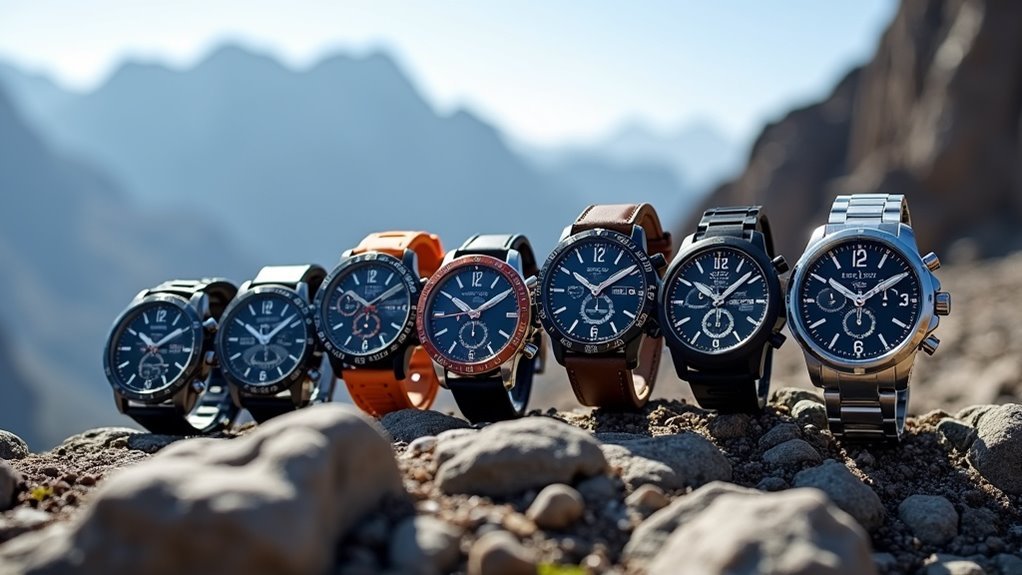
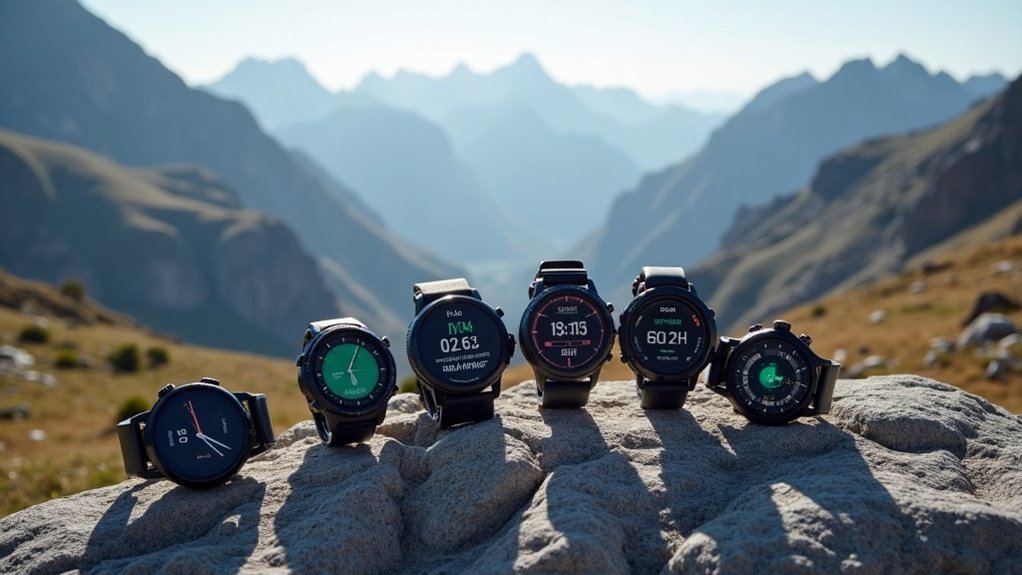
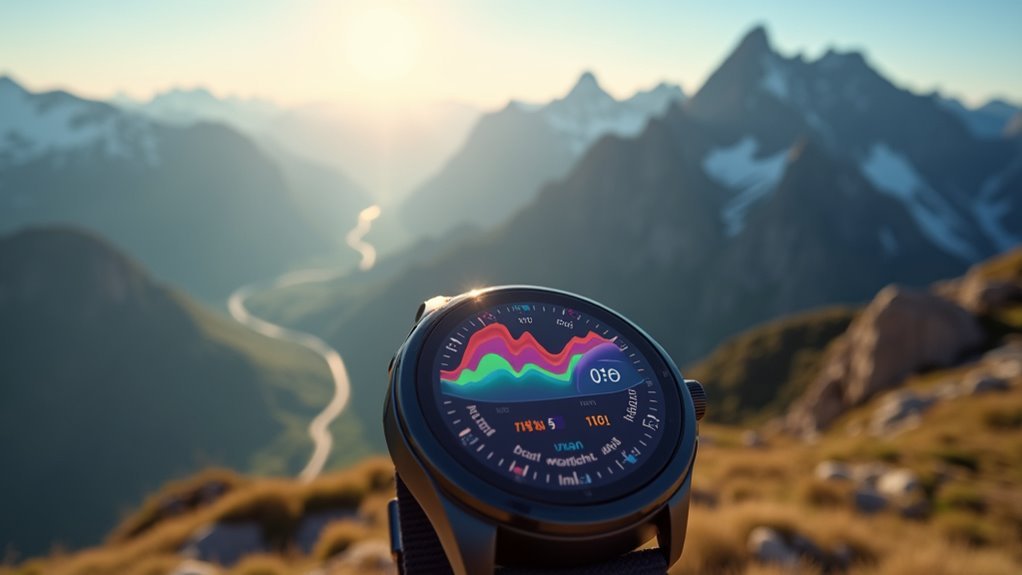
Leave a Reply